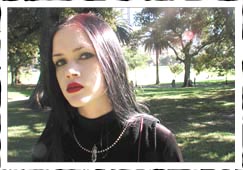 | |
| { Kodak Goes Goth for the Girls } Beth Sullivan photo courtesy Kodak A teenaged girl dressed in black with black hair, a pale face, and dark lipstick takes photographs of a sewer hole, twisted tree branches, and the off-kilter world of an amusement park. She presents a collage of the photos to her class. Her slumping peers sit up, furrowing their brows, aghast at these strange photographs. Only one classmate responds favorably: a similarly attired boy wearing eyeliner, who catches her eye and gives her a small grin. She smiles back at him knowingly. "The world is full of beautiful things/ beautiful people too/ beautiful people—like you," Bobby Darinís smooth voice continues, after the scene fades.
The teenaged characters of the ads donít only use disposable cameras—they create Web sites (whose addresses can be spied in the commercials) as well. They have a voice, and they canít contend themselves with the one-off aspect of school presentations. The goth girlís name is "Melanie," and her site can be found at www.seemyview.com. "Suziís" Web site is located at www.foundmyvoice.org. On the Web sites, the girls—portrayed as self-assured, smart, and creative in the television ads—come off as stereotypical, whiny, less intelligent, and less complex than they should be. Suzi writes: "I cant [sic] stand that some people think there [sic] better then [sic] every one else. I'm so tired of Ďcool peopleí.[sic] it's [sic] so old." Melanieís site features her collage and a poem about finding light in the darkness. Whoever constructed these offshoots probably enjoyed infusing them with all the cheesy, poorly-produced features associated with teen Web pages—animated gifs, terrible backgrounds, randomly placed images, misspelled words and bad punctuation. As a result, the characters and Kodak lose some credibility. Of course, both charactersí sites have links to Kodakís Web site. After all, the whole point is to sell a disposable camera to teen girls. To that end, Kodak succeeds in getting itself noticed. Search Google for "kodak goth girl commercial" and youíll find at least a few legitimate teensí Web logs speaking favorably of the spots. Itís admirable that Kodak has chosen to celebrate the individuality and creativity of young (female) teens, and they even do it in an elegant, fairly subtle way. Still, the ads—like most attempts at portraying the lives of teens realistically—fall victim to an exaggerated, glossy, tidy version of high school. Combined with Kodakís Web campaign, the scenes and characters prove no more real than Julie Lewisís new nose. View the ads at http://www.kodak.com/inside/insidestory.html. | |
 Tightly edited and graceful, the thirty second spot called "Goth" for Kodakís 1X-USE camera is pure cinema that depicts all the joy a throwaway camera can deliver—the enriching experience of exploring unusual aspects of familiar surroundings; the effective tactic of employing photographs in school presentations; the delightful ability of harmless images to shock others; the satisfaction of artistic self-expression; the pleasure of being understood (and, perhaps, misunderstood) by peers.
Tightly edited and graceful, the thirty second spot called "Goth" for Kodakís 1X-USE camera is pure cinema that depicts all the joy a throwaway camera can deliver—the enriching experience of exploring unusual aspects of familiar surroundings; the effective tactic of employing photographs in school presentations; the delightful ability of harmless images to shock others; the satisfaction of artistic self-expression; the pleasure of being understood (and, perhaps, misunderstood) by peers.